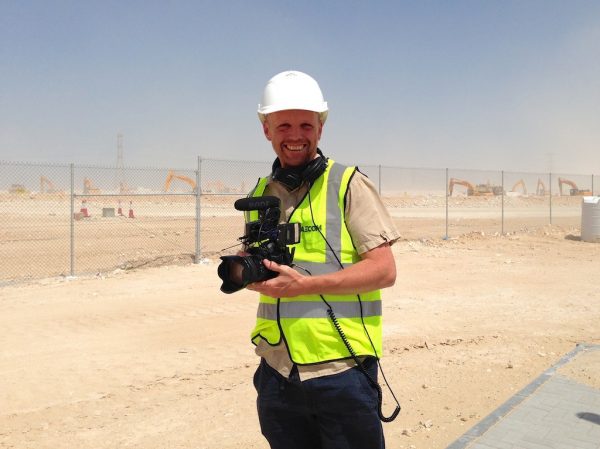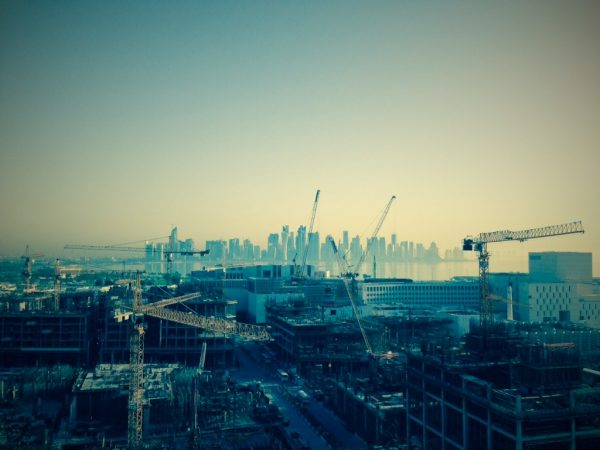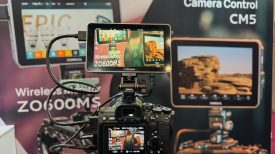Guest post by Pete Pattisson:
In 2000 I got my first photos published in a magazine. Fourteen years later I won a Webby Award for my film exposing the treatment of migrant workers in Qatar, host of the 2022 World Cup.
Along the way I’ve learned a few things about what it takes to succeed (or at least survive) as a freelance video journalist. I certainly don’t have all the answers, but I hope one or two of these tips may be helpful to some of you trying to break in to this most competitive of fields.
The type of work I do sometimes involves breaking news, but more often consists of in-depth investigations, which can take months to film.

I currently live in Nepal, where I’ve been focusing on documenting the experience of the country’s migrant workers in Qatar, for The Guardian newspaper. My latest film tells the story of a group of migrant workers who were not paid for over a year, despite fitting out a suite of luxury offices, some of which are currently occupied by the committee organising the 2022 World Cup.

So here are my ten tips:
1. It’s all about relationships
Like everything in life, success or failure is basically down to the relationships you build, whether that’s with your editor, your subjects or your fixer. It may seem obvious, but being professional and polite makes all the difference. Building up a network of good contacts is vital, because the key to making a great film is everything you do before you press the record button. Do as much as you can face-to-face, and if that’s not possible, use the phone. In particular, when you’re starting out, don’t email editors; emails are far to easy to ignore. Pick up the phone, or better still, go and visit them in person. However, don’t be too deferential. There’s nothing wrong with asking for a higher fee, or arguing your case about how your film should be edited.
2. Does social networking work?
Having said that networking is important, I’m not convinced social networking has the same benefit. I find it much more valuable to spend an hour talking to a local journalist, than spend an hour on Twitter. Now you can, of course, do both, but it makes sense to focus your efforts on what will have most impact, and in my experience that means producing good material. Almost all the work I have got has come from people who have seen what I have already done. The best way to get work, is to do work.
3. Don’t rely on video alone
I started out as a photographer, then I realised how hard it is to earn a living through photos alone, so I started writing and subsequently making films. This has three advantages. It means you can offer editors a complete package: text, photos and video. It means you have three potential sources of income. And it allows you to tell a story through the most appropriate medium. Not every story lends itself to video, so match your medium to your story.
4. Be a specialist
There are good reasons to start out as a generalist, building up your experience by making films in a range of settings and on a range of issues, but I chose a different route. From the start I specialised in stories about labour rights, and in particular modern forms of slavery. I spent a year documenting different forms of slavery around the world, and then published a book and held an exhibition in central London.
Initially I made a massive financial loss on the project, but it gave me a platform to publicise both the issue and myself. On the back of the project I got numerous articles published in newspapers and magazines, and photos from the project were subsequently exhibited in the US, France, India and at the United Nations in Geneva. And I eventually broke even, about five years after I completed the project.
5. Go and live somewhere remote
Journalism is so competitive, it makes little sense to base yourself in New York, London, Delhi or Beijing when you’re starting out. All the big newspapers have correspondents there and you may struggle to establish yourself. But it’s much easier to get noticed if you’re pitching good stories from a place where there are few other journalists. Furthermore, the cost of living in the remoter parts of the world is often (but not always) much less.
6. They are called newspapers for a reason
Newspapers publish the news. And so the easiest way to get published is to put yourself at the centre of a news story, preferably before anyone else. The first film I ever got published by The Guardian was from Burma, days after Cyclone Nargis devastated the country. I happened to visit a camp for people displaced by the cyclone just as General Than Shwe, the then leader of Burma, arrived in a giant motorcade. I managed to take some photos of him (before I was arrested, and then escaped). I had no problem getting that film published!
7. Shoot actuality
Actuality means things that are happening live in front of you, for example a protest, a funeral or a rescue. This is the stuff that makes for really gripping viewing, and from my experience it’s what editors are most interested in. Seeing the event in real time is much more powerful than listening to someone retell the event afterwards. In other words. ‘show, don’t tell’. One of the best suggestions I ever got (which I think came from Adam Westbrook’s interesting blog) is to watch your film with the sound turned off. If it’s still interesting you’ve probably made a good film. If not, have a re-think.
8. Equipment matters (but not that much)
Equipment matters, but it’s the story that trumps everything. My Webby-winning film on migrant workers in Qatar, was almost entirely shot with a Canon 60D, a Rode Videomic Pro, a Canon 28mm f1.8 and a 17-40mm f4L. So you really don’t need top-of-the-line equipment to make a decent film, especially as most video journalism is published in highly compressed form on the web.
I would argue that the ideal tool for video journalism is a small camcorder. When you are shooting actuality, you want to at least have the option of auto-everything. Having said that, I’m sticking with DSLRs largely because I can shoot video and stills with one camera.
What’s the best DSLR for video journalism? If you’re just starting out and want to keep costs down, the Canon 60D with Magic Lantern software is not a bad place to begin. I’ve recently started using mine with a Beachtek two channel audio adaptor, which gives me much more control over audio levels.
I would like to be able to recommend the 70D because of its excellent autofocus and remarkably smooth electronic aperture; however, both these features only work really well with Canon’s very slow STM lenses. Furthermore, until we get Magic Lantern for the 70D, there’s no way to monitor the audio through headphones. So if you can afford it, the obvious solution appears to be the Panasonic GH4 or Sony a7S.
9. You’re not a journalist; you’re an entrepreneur
Being a successful freelance video journalist means being a successful entrepreneur. If you can’t make money, you can’t make films. So before you buy anything – a camera, lens, website, software – figure out how many films you are going to have to sell in order to cover the cost. If you do have money to spend, spend it on making films. Think about how to avoid or minimise the really big costs, like flights, hotels and translators. One way around this is to shoot local; you don’t have to go halfway around the world to make a great film. The ideal solution of course is to get an editor to commission you, but in my experience this is quite hard to do when you’re starting out. Conversely, try to diversify your sources of income. As a rule, newspapers do not pay very well, but NGOs and corporates do, so look to them for work too. And there’s nothing wrong in starting out part-time – for a long time I fitted my journalism around working full-time as a teacher.
10. Be persistent
That’s it.
You can find out more about Pete Pattisson’s work on his website.





